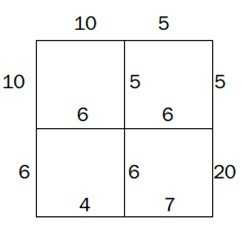标签:

思路:和上一题http://www.cnblogs.com/EdsonLin/p/5574033.html差不多,不过这一题直接给了点权,所以逻辑上感觉好理解一点吧

#include <iostream> #include <cstdio> #include <cstdlib> #include <cstring> #include <cmath> #include <stack> #include <string> #include <queue> #include <vector> #include <algorithm> #include <ctime> using namespace std; //#define EdsonLin #ifdef EdsonLin #define debug(...) fprintf(stderr,__VA_ARGS__) #else #define debug(...) #endif //EdsonLin typedef long long ll; typedef double db; const int inf = 0x3f3f3f; const int MAXN = 410; const int MAXNN = 160000; const int MAXM = 1e6; //const int MAXM = 3e4+100; const int MOD = 1000000007; const db eps = 1e-3; #define PB push_back struct dij{ int n,m; int first[MAXNN]; struct edge{ int st,to,next,dist; }; vector<edge>e; int top; int d[MAXNN]; //s到各节点的距离 int done[MAXNN]; //是否已经被永久标记 int p[MAXNN]; //记录上一条边 struct heapnode{ int st; int dist; bool operator < (const heapnode& rhs) const { return dist>rhs.dist; } }; void init(int n){ this->n = n; memset(first,-1,sizeof(first)); top = 0; e.clear(); } void addedge(int u,int v,int dist){ /*e[top].st = u; e[top].to = v; e[top].dist = dist; e[top].next = first[u]; first[u] = top++;*/ edge a; a.st = u; a.to = v; a.dist = dist; a.next = first[u]; e.PB(a); first[u] = top++; //cout<<first[u]<<endl; //cout<<top<<endl; } void pqdij(int s){ priority_queue<heapnode>Q; heapnode a; for(int i=0;i<n;i++) d[i] = inf; d[s] = 0; memset(done,0,sizeof(done)); a.dist = 0; a.st = s; Q.push(a); while(!Q.empty()){ heapnode x = Q.top(); Q.pop(); int u = x.st; if(done[u])continue; done[u] = 1; for(int i=first[u];i!=-1;i=e[i].next){ if(d[e[i].to]>d[u]+e[i].dist){ d[e[i].to] = d[u] + e[i].dist; p[e[i].to] = i; a.dist = d[e[i].to]; a.st = e[i].to; Q.push(a); } } } } }solver; int readint(){int x;scanf("%d",&x);return x;} int main() { #ifdef EdsonLin //freopen("1.in","r",stdin); //freopen("1.out","w",stdout); int _time_ed = clock(); #endif //EdsonLin int T; scanf("%d",&T); int mc=0,grid[MAXN][MAXN]; while(mc++<T){ int n,st,ed; cin>>n; for(int i=1;i<=n;i++){ for(int j=1;j<=n;j++) grid[i][j] = readint(); } st = 0;ed = (n-1)*(n-1)+1; solver.init(ed+1); for(int i=1;i<n;i++){ for(int j=1;j<n;j++){ int cur = (i-1)*(n-1)+j; if(i==1){ solver.addedge(cur,ed,grid[i][j]); solver.addedge(ed,cur,grid[i][j]); } if(i!=n-1){ solver.addedge(cur,cur+n-1,grid[i+1][j]); solver.addedge(cur+n-1,cur,grid[i+1][j]); } if(i==n-1){ solver.addedge(st,cur,grid[i+1][j]); solver.addedge(cur,st,grid[i+1][j]); } if(j==1){ solver.addedge(st,cur,grid[i][j]); solver.addedge(cur,st,grid[i][j]); } if(j!=n-1){ solver.addedge(cur,cur+1,grid[i][j+1]); solver.addedge(cur+1,cur,grid[i][j+1]); } if(j==n-1){ solver.addedge(cur,ed,grid[i][j+1]); solver.addedge(ed,cur,grid[i][j+1]); } } } solver.pqdij(st); printf("%d\n",solver.d[ed]); } #ifdef EdsonLin debug("time: %d\n",int(clock()-_time_ed)); #endif //EdsonLin // cout << "Hello world!" << endl; return 0; }
标签:
原文地址:http://www.cnblogs.com/EdsonLin/p/5574041.html